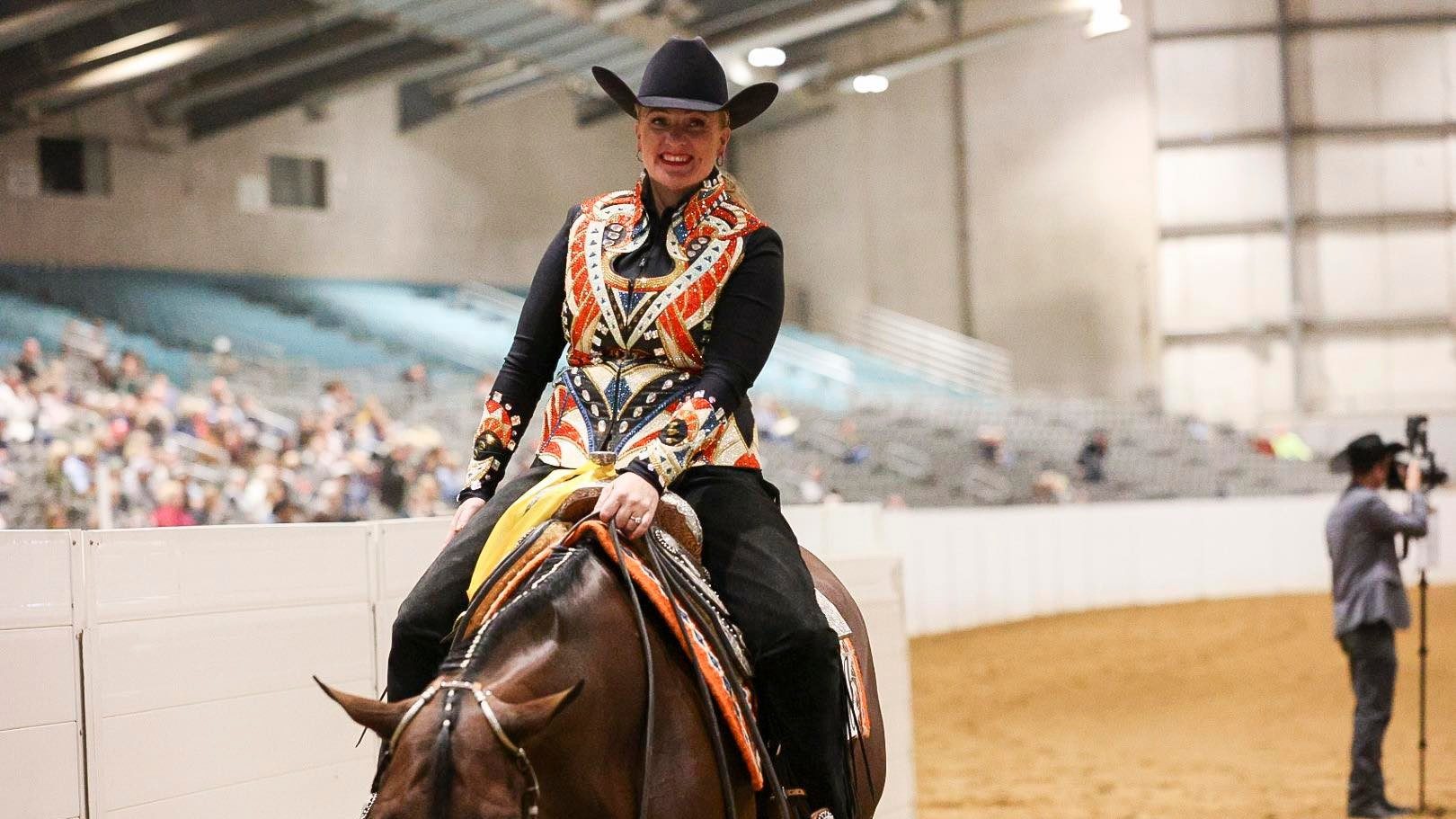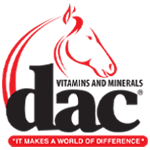The trick and skill of showing in the western pleasure is to make it actually look like a pleasure – and it’s a lot harder than it seems!
According to AQHA, “Judges must consider overall gracefulness, relaxed expression, topline, softness of movement, consistency, and length of stride of the designated gait,” when judging a pleasure class.
A horse that travels on a loose rein with a stretched, level neck and alert expression is one of the best ways to paint an overall picture of a horse that is not only good at its job, but enjoys its job. Unfortunately, a horse that travels with a bowed, excessively bobbing neck does the exact opposite.
We spoke with top western pleasure trainers Brian Baker (Baker Futurity Horses) and Katy Jo Zuidema (Zuidema Pleasure Horses) for their advice on how to fix an over-bridled horse.
Release the Pressure
One of the most common reasons why a horse will flex its face and bow its neck is that the rider goes to their face to slow them down.
“Nine times out of ten, I have to remind the rider to let the horse carry them and not get in their way,” Baker laughs.
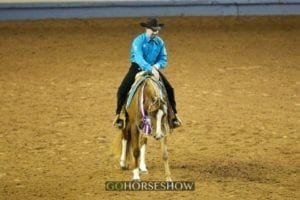 Brian finds that many amateurs inadvertently push their horse forward with their body and then go to their face to slow them down – which results in the rider’s body and hands working against each other and a frustrated horse.
Brian finds that many amateurs inadvertently push their horse forward with their body and then go to their face to slow them down – which results in the rider’s body and hands working against each other and a frustrated horse.
“The horse will naturally bend their mouth to pressure, which will result in them bringing their face back toward their body, which is the opposite of what you want them to do,” Baker reminds us. “Before you start wondering what the horse is doing, you need to make sure the horse isn’t simply responding to the rider.”
Zuidema cautions, however, that simply letting go of their face is ill-advised. Specifically, she says, “If you are going to release pressure on their face with the hope that they will level out and carry themselves correctly, the timing of your release is the most-important consideration.”
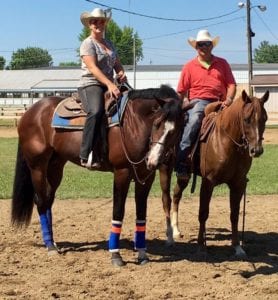 Katy Jo explains, “You reward a horse with the release, so if you let go and stop pulling when their neck is bowed, you’ve just told them that is what you want. This is why it is very important to avoid giving them the release when they are doing something counter-productive.”
Katy Jo explains, “You reward a horse with the release, so if you let go and stop pulling when their neck is bowed, you’ve just told them that is what you want. This is why it is very important to avoid giving them the release when they are doing something counter-productive.”
Zuidema’s rule of thumb is, “If you’re going to get into their face, do it with purpose. And, when it is time to release, do it bigger (so the horse really feels the reward) and with the correct timing (so the horse understands what you are rewarding).”
Build Their Strength
The ability to stretch their neck out while moving with control and cadence requires serious self-carriage on the part of the horse. And the only way for a horse to get this self-carriage is to be strong enough in the body to find it and maintain it.
“I really like to work on breaking down the parts of their body and making each individual part strong so that the muscle groups support each other and allow for better self-carriage,” Brian explains.
“I don’t like to ask for everything at once because I find horses get frustrated,” Baker continues. Indeed, you wouldn’t start training for a marathon by running 26 miles on your first practice. He adds, “I like to gradually ease the horse into preparing the muscles to be able to engage and do what I want them to do in the long term. It’s a slow and steady process, but it yields the most consistent results.”
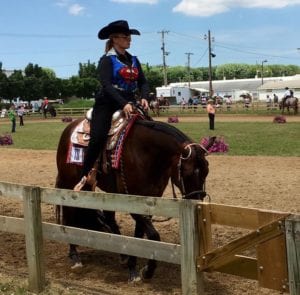 Zuidema does a lot of her body conditioning in the round pen to teach the horse how to lope without using their neck to do it. “When you take the counterbalance of the neck away from them, they have to learn to use different muscles in their body to carry themselves properly at the lope.”
Zuidema does a lot of her body conditioning in the round pen to teach the horse how to lope without using their neck to do it. “When you take the counterbalance of the neck away from them, they have to learn to use different muscles in their body to carry themselves properly at the lope.”
For this reason, Katy Jo believes that western pleasure is particularly difficult for the animals. “We have to have them be really broke, but we don’t want to pack them in bridle. They need to round their back and pick up their shoulder while flattening their neck, which takes a lot of body control because the physics of it are not always natural to them,” she explains.
“The majority of horses are simply not physically capable of this movement and your best bet to getting them even close to what is expected is to make sure they are strong enough to even attempt it. Therefore, time and patience are your best friends,” Zuidema says.
Build Their Mental Endurance
Being strong in the body is only a part of the equation. You also need the horse to be in a mental place to enjoy their job. Unlike people, horses aren’t good at “faking it,” they can’t have good expression if they truly dislike their job.
 Baker recommends you change up their training regimen at home. If your horse is a pleasure horse, don’t just work on riding along the rail all the time. “Horses get bored too,” he says. “I like to practice with poles or western riding on my pleasure horses to work out both their body and their minds.”
Baker recommends you change up their training regimen at home. If your horse is a pleasure horse, don’t just work on riding along the rail all the time. “Horses get bored too,” he says. “I like to practice with poles or western riding on my pleasure horses to work out both their body and their minds.”
Zuidema agrees that allowing both the horse and rider to get a mental break from the rigors of western pleasure body-positioning is a great way to go back to their top line with less frustration.
However, Katy Jo cautions that, when doing so, it is important to change your tack to signal to your horse that your expectations are changing.
“I will change the equipment, like putting a snaffle on them for other events so that they could understand the difference of head and neck carriage. Horses are creatures of habit. It is great to give them a mental break, but you don’t want them to forget all your hard work.”
The neck/head set is often the finishing touch on a collected horse. But the finishing touches are also the first to go when the horse gets lazy or bored. If you find a horse losing their headset, it’s time to change up the routine and see if, when you return to the pleasure movement, they are in a better head space to do what you ask.
Find Their Sweet Spot
Every horse is different and some horses are built such that they need to work harder to maintain the proper top line. The best way to help your horse be their best is to know your horse and where they are most comfortable moving.
To find where a horse is most comfortable moving correctly, Baker will play around with their speed. He explains, “I like to play with their stride and bring them in tight and then let them move out to see where they naturally want to move the best.”
He adds, “Gone are the days where the slowest horse wins the class. Now, it is the more correct, fluid, and soft horses that tend to place the highest. So, I make it a point to find where the horse wants to move closest to the standard and then tweak it from there. The more comfortable they are, the easier it is to give them a strong, level headset.”
 Zuidema agrees that the best way to maintain a level neck carriage is to ask your horse to give their individual best performance. “If you have a B+ horse and you ask it to give an A+ performance, you will get a C+ result. But if you ask your B+ horse to be their best version of a B+ horse, your chances of actually turning in an A+ performance dramatically increase,” Zuidema explains.
Zuidema agrees that the best way to maintain a level neck carriage is to ask your horse to give their individual best performance. “If you have a B+ horse and you ask it to give an A+ performance, you will get a C+ result. But if you ask your B+ horse to be their best version of a B+ horse, your chances of actually turning in an A+ performance dramatically increase,” Zuidema explains.
“You want your horse to show with confidence and consistency and they will never do that if you are asking them to maintain something they aren’t physically capable of. They will just learn to hate their job,” Katy Jo warns.
“The pleasure standard caters to the 1% of horses that can actually maintain correctness with a level top line at a very slow speed. Sometimes it actually looks better if their neck is slightly elevated or their speed is a little faster, so long as they are going around correctly and comfortably.”
Zuidema says she makes it a point to find each of her horse’s “most comfortable, consistent speed, and self-carriage and go from there to get them as close to the standard as they are capable.”


